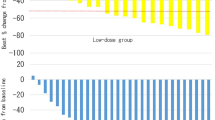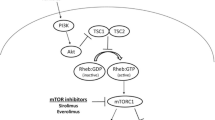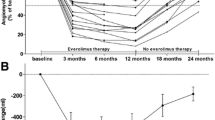Abstract
Background
Renal angiomyolipoma (RAML) is the most common kidney lesion in patients with tuberous sclerosis complex (TSC), affecting about 80% of patients. It is a benign tumor that grows over time, usually bilaterally, and can easily lead to kidney complications such as acute hemorrhage. Herein, we investigated the efficacy and safety of sirolimus in children with TSC-associated RAML and explored the factors affecting tumor disappearance under sirolimus treatment through subgroup analysis.
Methods
A prospective cohort study was conducted. Sirolimus was initiated at 1 mg/(m2 × day), and dose adjustments were made by a 2-week titration period to attain a trough blood concentration of 5–10 ng/mL. The disappearance of RAML in children after sirolimus treatment was observed, and Cox regression was used to screen the factors affecting tumor disappearance.
Results
One hundred and twenty-six patients who met the criteria were analyzed. After 3 months, 6 months, 12 months, and 24 months of follow-up, tumors disappeared in 18 (14.3%), 30 (23.8%), 39 (31.0%), and 42 (33.3%) children, respectively. Tumors disappeared in 50 (39.7%) children by the last visit of each individual, and 30 (60%) of them occurred within 6 months. The multivariate Cox regression analysis showed that patients with a smaller maximum tumor diameter at baseline had a higher tumor disappearance rate. Thirty-six (29%) patients had stomatitis during the entire treatment period, and no serious adverse reactions were observed.
Conclusions
Sirolimus could promote the disappearance of TSC-related RAML. The disappearance rate was correlated with the maximum diameter at baseline, and the smaller the tumor was, the higher the disappearance rate. It is well tolerated in the treatment of RAML associated with TSC.
Graphical abstract


Similar content being viewed by others
Data availability
The data of this study are available on reasonable request to the corresponding author.
References
Curatolo P, Bombardieri R, Jozwiak S. Tuberous sclerosis. Lancet. 2008;372:657–68.
Bissler JJ, Kingswood JC, Radzikowska E, Zonnenberg BA, Frost M, Belousova E, et al. Everolimus for angiomyolipoma associated with tuberous sclerosis complex or sporadic lymphangioleiomyomatosis (EXIST-2): a multicentre, randomised, double-blind, placebo-controlled trial. Lancet. 2013;381:817–24.
Kingswood JC, Belousova E, Benedik MP, Carter T, Cottin V, Curatolo P, et al. Renal angiomyolipoma in patients with tuberous sclerosis complex: findings from the TuberOus SClerosis registry to increase disease Awareness. Nephrol Dial Transplant. 2019;34:502–8.
Bissler JJ, Christopher KJ. Renal manifestation of tuberous sclerosis complex. Am J Med Genet C Semin Med Genet. 2018;178:338–47.
Habib SL, Al-Obaidi NY, Nowacki M, Pietkun K, Zegarska B, Kloskowski T, et al. Is mTOR inhibitor good enough for treatment all tumors in TSC patients? J Cancer. 2016;7:1621–31.
Yamakado K, Tanaka N, Nakagawa T, Kobayashi S, Yanagawa M, Takeda K. Renal angiomyolipoma: relationships between tumor size, aneurysm formation, and rupture. Radiology. 2002;225:78–82.
Kingswood JC, Bissler JJ, Budde K, Hulbert J, Guay-Woodford L, Sampson JR, et al. Review of the tuberous sclerosis renal guidelines from the 2012 Consensus Conference: current data and future study. Nephron. 2016;134:51–8.
Nason GJ, Morris J, Bhatt JR, Richard PO, Martin L, Ajib K, et al. Natural history of renal angiomyolipoma favors surveillance as an initial approach. Eur Urol Focus. 2021;7:582–8.
Warncke JC, Brodie KE, Grantham EC, Catarinicchia SP, Tong S, Kondo KL, et al. Pediatric renal angiomyolipomas in tuberous sclerosis complex. J Urol. 2017;197:500–6.
Amin S, Lux A, Calder N, Laugharne M, Osborne J, O’Callaghan F. Causes of mortality in individuals with tuberous sclerosis complex. Dev Med Child Neurol. 2017;59:612–7.
Swallow E, King S, Song J, Peeples M, Signorovitch JE, Liu Z, et al. Patterns of disease monitoring and treatment among patients with tuberous sclerosis complex-related angiomyolipomas. Urology. 2017;104:110–4.
Bhatt JR, Richard PO, Kim NS, Finelli A, Manickavachagam K, Legere L, et al. Natural history of renal angiomyolipoma (AML): most patients with large AMLs >4 cm can be offered active surveillance as an initial management strategy. Eur Urol. 2016;70:85–90.
Krueger DA, Northrup H, International Tuberous Sclerosis Complex Consensus Group. Tuberous sclerosis complex surveillance and management: recommendations of the 2012 International Tuberous Sclerosis Complex Consensus Conference. Pediatr Neurol. 2013;49:255–65.
MacKeigan JP, Krueger DA. Differentiating the mTOR inhibitors everolimus and sirolimus in the treatment of tuberous sclerosis complex. Neuro Oncol. 2015;17:1550–9.
Luo C, Zhang YS, Zhang MX, Chen MF, Li Y, Qi L, et al. Everolimus versus sirolimus for angiomyolipoma associated with tuberous sclerosis complex: a multi-institutional retrospective study in China. Orphanet J Rare Dis. 2021;16:299.
Davies DM, de Vries PJ, Johnson SR, McCartney DL, Cox JA, Serra AL, et al. Sirolimus therapy for angiomyolipoma in tuberous sclerosis and sporadic lymphangioleiomyomatosis: a phase 2 trial. Clin Cancer Res. 2011;17:4071–81.
Bissler JJ, McCormack FX, Young LR, Elwing JM, Chuck G, Leonard JM, et al. Sirolimus for angiomyolipoma in tuberous sclerosis complex or lymphangioleiomyomatosis. N Engl J Med. 2008;358:140–51.
Cabrera-Lopez C, Marti T, Catala V, Torres F, Mateu S, Ballarin J, et al. Assessing the effectiveness of rapamycin on angiomyolipoma in tuberous sclerosis: a two years trial. Orphanet J Rare Dis. 2012;7:87.
Northrup H, Krueger DA, International Tuberous Sclerosis Complex Consensus Group. Tuberous sclerosis complex diagnostic criteria update: recommendations of the 2012 International Tuberous Sclerosis Complex Consensus Conference. Pediatr Neurol. 2013;49:243–54.
Lemaitre L, Claudon M, Dubrulle F, Mazeman E. Imaging of angiomyolipomas. Semin Ultrasound CT MR. 1997;18:100–14.
Halpenny D, Snow A, McNeill G, Torreggiani WC. The radiological diagnosis and treatment of renal angiomyolipoma-current status. Clin Radiol. 2010;65:99–108.
Schwartz GJ, Gauthier B. A simple estimate of glomerular filtration rate in adolescent boys. J Pediatr. 1985;106:522–6.
Schwartz GJ, Munoz A, Schneider MF, Mak RH, Kaskel F, Warady BA, et al. New equations to estimate GFR in children with CKD. J Am Soc Nephrol. 2009;20:629–37.
Staples A, LeBlond R, Watkins S, Wong C, Brandt J. Validation of the revised Schwartz estimating equation in a predominantly non-CKD population. Pediatr Nephrol. 2010;25:2321–6.
Dun S, Zou LP, Zhang MN, Wang YY, He W, Chen HM, et al. Rapamycin in the treatment of renal diseases associated with tuberous sclerosis complex. Zhonghua Er Ke Za Zhi. 2019;57:852–6 (in Chinese).
Bissler JJ, Franz DN, Frost MD, Belousova E, Bebin EM, Sparagana S, et al. The effect of everolimus on renal angiomyolipoma in pediatric patients with tuberous sclerosis being treated for subependymal giant cell astrocytoma. Pediatr Nephrol. 2018;33:101–9.
Dabora SL, Franz DN, Ashwal S, Sagalowsky A, DiMario FJ Jr, Miles D, et al. Multicenter phase 2 trial of sirolimus for tuberous sclerosis: kidney angiomyolipomas and other tumors regress and VEGF-D levels decrease. PLoS One. 2011;6:e23379.
Bissler JJ, Nonomura N, Budde K, Zonnenberg BA, Fischereder M, Voi M, et al. Angiomyolipoma rebound tumor growth after discontinuation of everolimus in patients with tuberous sclerosis complex or sporadic lymphangioleiomyomatosis. PLoS One. 2018;13:e0201005.
Wang W, Guo H, Shi B, Sun H, Li H, Zhang Y, et al. CT characteristics predict the response to everolimus or sirolimus of renal angiomyolipomas in patients with tuberous sclerosis complex. Int Urol Nephrol. 2019;51:671–6.
Wu CQ, Wolf DS, Smith EA. Fate of pediatric renal angiomyolipoma during mTOR inhibitor treatment in tuberous sclerosis complex. Urology. 2020;139:161–7.
Godel M, Hartleben B, Herbach N, Liu S, Zschiedrich S, Lu S, et al. Role of mTOR in podocyte function and diabetic nephropathy in humans and mice. J Clin Invest. 2011;121:2197–209.
Decleves AE, Sharma K. Novel targets of antifibrotic and anti-inflammatory treatment in CKD. Nat Rev Nephrol. 2014;10:257–67.
Zou L, Liu Y, Pang L, Ju J, Shi Z, Zhang J, et al. Efficacy and safety of rapamycin in treatment of children with epilepsy complicated with tuberous sclerosis. Zhonghua Er Ke Za Zhi. 2014;52:812–6 (in Chinese).
Chen XQ, Wang YY, Zhang MN, Lu Q, Pang LY, Liu LY, et al. Sirolimus can increase the disappearance rate of cardiac rhabdomyomas associated with tuberous sclerosis: a prospective cohort and self-controlled case series study. J Pediatr. 2021;233:150–5.e4.
He W, Chen J, Wang YY, Zhang MN, Qian L, Wang QH, et al. Sirolimus improves seizure control in pediatric patients with tuberous sclerosis: a prospective cohort study. Seizure. 2020;79:20–6.
Acknowledgements
We thank all enrolled patients and their parents or guardians.
Funding
This study was funded by the Capital's Funds for Health Improvement and Research (No. 2022-1-5081) and National Key Research and Development Program of China (No. 2016YFC1000707).
Author information
Authors and Affiliations
Contributions
DS and WYY conceived and designed the study, collected data, analyzed the data and drafted the initial manuscript, and revised the manuscript. WL conceived and designed the study, analyzed the data and drafted the initial manuscript, and revised the manuscript. WQH, LQ, YXY, ZQ, and CHM collected data and reviewed the manuscript. QLP analyzed the data and drafted the initial manuscript, and revised the manuscript. ZLP conceived and designed the study, and reviewed the manuscript. All the authors approved the final manuscript and agreed to be accountable for all aspects of the work.
Corresponding author
Ethics declarations
Ethical approval
This study has been performed in line with the principles of the Declaration of Helsinki. Ethical approval was obtained from the Ethics Committee of the PLA General Hospital (No. S2013-028-01). Written informed consent was obtained from legal guardians of all enrolled participants included in the study.
Conflict of interest
The authors declare no competing interests. No financial or non-financial benefits have been received or will be received from any party related directly or indirectly to the subject of this article.
Additional information
Publisher's Note
Springer Nature remains neutral with regard to jurisdictional claims in published maps and institutional affiliations.
Rights and permissions
Springer Nature or its licensor (e.g. a society or other partner) holds exclusive rights to this article under a publishing agreement with the author(s) or other rightsholder(s); author self-archiving of the accepted manuscript version of this article is solely governed by the terms of such publishing agreement and applicable law.
About this article
Cite this article
Dun, S., Wang, YY., Wan, L. et al. Sirolimus can promote the disappearance of renal angiomyolipoma associated with tuberous sclerosis complex: a prospective cohort study. World J Pediatr (2023). https://doi.org/10.1007/s12519-023-00751-5
Received:
Accepted:
Published:
DOI: https://doi.org/10.1007/s12519-023-00751-5




